The best plants for a balcony. Setting up their little garden is a dream for people who enjoy plants.
If you want to add plants to your balcony, here is a list of thirty plants that will thrive in the confined outdoor space.
30 Plants that are best for the Balcony
- Bamboo
- English Ivy
- Butterfly bush
- Big bluestem
- Yellow Indian Grass
- Arborvitae
- Canna Lily
- Princess Flower
- Hops
- Rose of Sharon
- Viburnum
- Dracaena
- Skip Laurel
- Amarnath
- Fuchsia
- Horsetail
- Hydrangea
- Elderberry
- Switchgrass
- Elephant Ear
- Holly
- Fountain Grass
- Clematis
- Junipers
- Areca Palm
- Yucca
- Bird of Paradise
- Norfolk Island Pine
- Boxwood
- Sweet Bay Laurel

Best plants for the Balcony
1. Bamboo
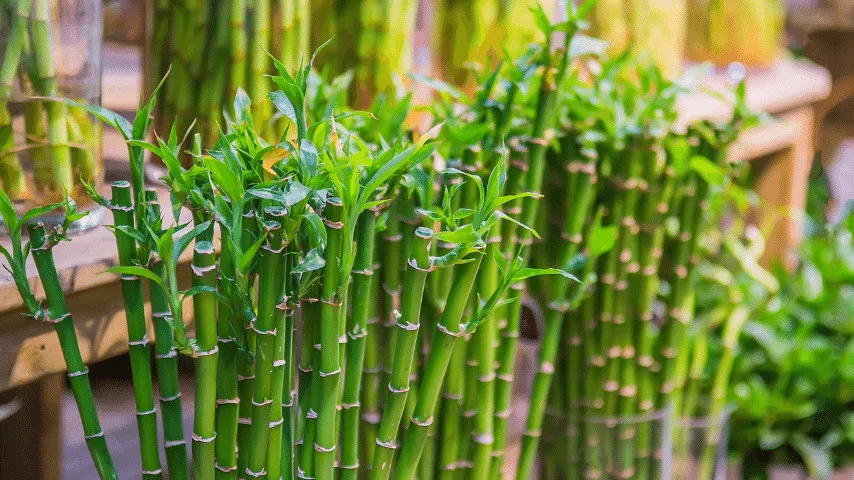
There are variations of the Bamboo plant meant for container growth. These are ideal for East or West-facing balconies, even with minimal sunlight.
This is a low-maintenance plant. Choose a variety that works for your patio/balcony.
The decorative appeal of this plant has placed it among the most used indoor and outdoor choices for anyone who enjoys plants.
Its binomial nomenclature and fundamental plant care requirements are as follows:
- Scientific Name: Bambusoideae
- Family: Poaceae
- Temperature: 60⁰ F to 70⁰ degrees Fahrenheit (15.5 to 21.11 degrees Celsius)
- Fertilizer: nitrogen-rich slow-release fertilizer
- pH: 5 to 6.5
- Soil: loamy, well-drained soil
- Lighting: up to 6 hours of shaded sunlight
- Growth rate: moderate growth rate
- Humidity: 60-80% humidity is recommended
2. English Ivy
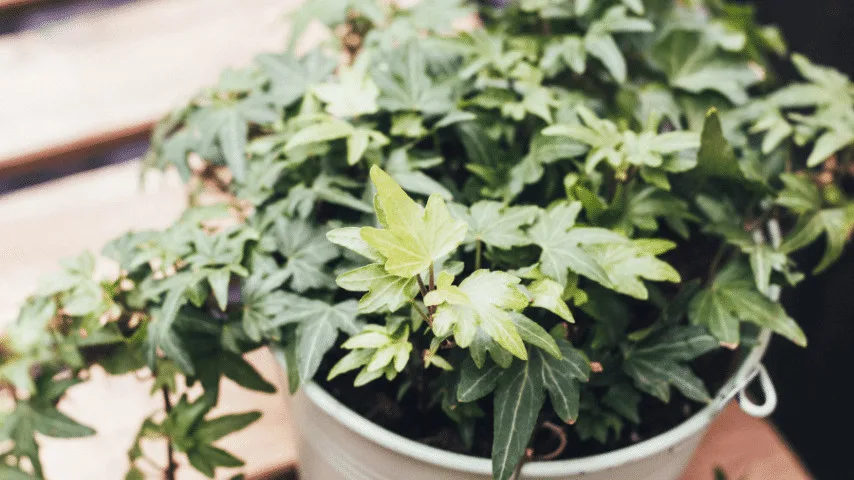
English Ivy vine-like plant is ideal for balconies with wooden frames. All it needs is mild sunlight and a supporting structure to cover an area of the wall or create a boundary.
The gorgeous leaves of this beautiful plant compliment the smallest of spaces and add texture to any balcony with minimal décor.
Its binomial nomenclature and fundamental plant care requirements are as follows:
- Scientific Name: Hedera Helix
- Family: Araliaceae
- Temperature: 65⁰ F to 85⁰ degrees Fahrenheit (18.33 to 29.44 degrees Celsius)
- Fertilizer: does not need fertilizer
- pH: 6.5 to 7
- Soil: well-draining soil
- Lighting: bright indirect sunlight
- Growth rate: fast growth rate
- Humidity: 65-85% humidity is recommended
3. Butterfly bush
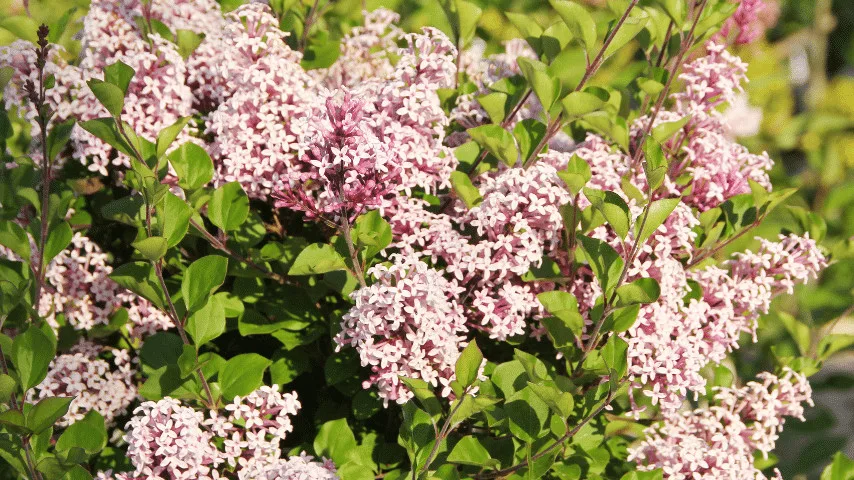
If your balcony has a particularly sunny spot, place a butterfly bush plant there.
The vibrant flowers against the lush green leaves make for an eye-catching addition to the balcony.
This plant thrives in most conditions, even with minimal maintenance.
Its binomial nomenclature and fundamental plant care requirements are as follows:
- Scientific Name: Buddleja
- Family: Buddlejaceae
- Temperature: 30⁰ F to 90⁰ degrees Fahrenheit (-1.11 to 32.22 degrees Celsius)
- Fertilizer: organic manure-based
- pH: 5.5 to 8.5
- Soil: moderately alkaline soil
- Lighting: 8 hours or so
- Growth rate: fast growth rate
- Humidity: 80-100% humidity
4. Big bluestem
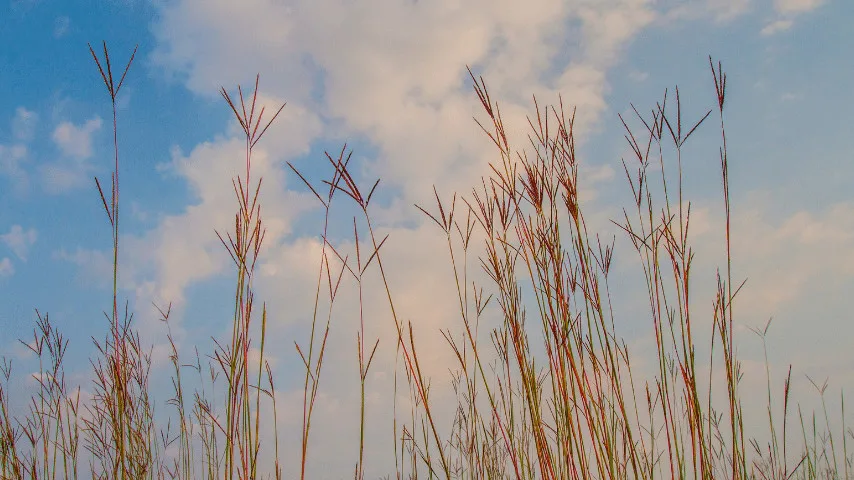
This adaptable long grass-like plant is ideal for rectangular pots placed along the balcony fence.
According to the University of North Carolina, Andropogon gerardii can grow 4-8 feet (122-244cm) tall and 2-3 feet (61-92cm) wide.
Since these plants love sunlight, they will thrive in the lesser shady areas of the space.
These make the perfect ornaments for larger balconies with tons of direct sunlight.
Its binomial nomenclature and fundamental plant care requirements are as follows:
- Scientific Name: Andropogon gerardii
- Family: grasses
- Temperature: 80⁰ F to 90⁰ degrees Fahrenheit (26.66 to 32.22 degrees Celsius)
- Fertilizer: does not need fertilizer
- pH: 4.8 to 6.9
- Soil: sandy, loamy, and well-draining
- Lighting: 8 hours a day
- Growth rate: fast growth rate
- Humidity: 35-50% humidity is recommended
5. Yellow Indian Grass
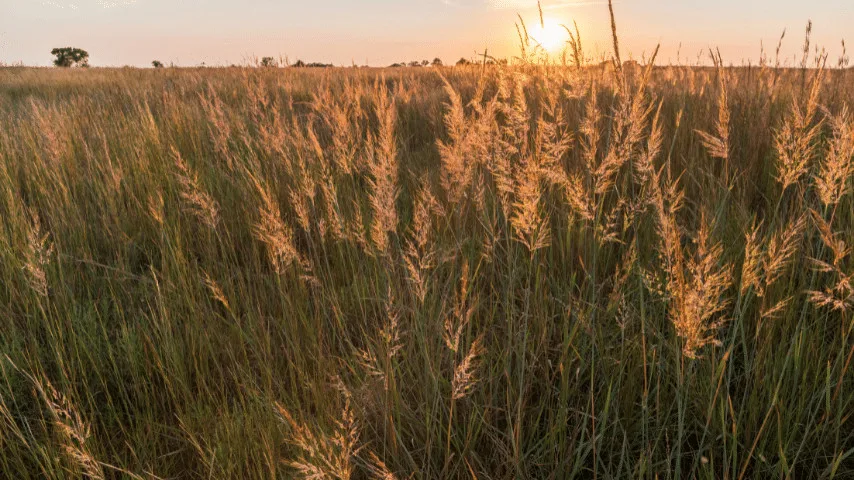
This ornamental grass plant is ideal for balconies that experience ample sunlight.
The gorgeous blue-green shades of the foliage pair well with the reflective light adding a pop of color to the mix.
If you are one of those people who enjoy evenings sitting on the balcony, then this is the plant for you.
Its binomial nomenclature and fundamental plant care requirements are as follows:
- Scientific Name: Sorghastrum nutans
- Family: Poaceae
- Temperature: 85⁰ F to 95⁰ degrees Fahrenheit (29.44 to 35 degrees Celsius)
- Fertilizer: does not need fertilizer
- pH: 4.8 to 8
- Soil: sandy-loam, well-draining soils
- Lighting: 6 hours or so
- Growth rate: fast growth rate
- Humidity: 50-90% humidity is recommended
6. Arborvitae
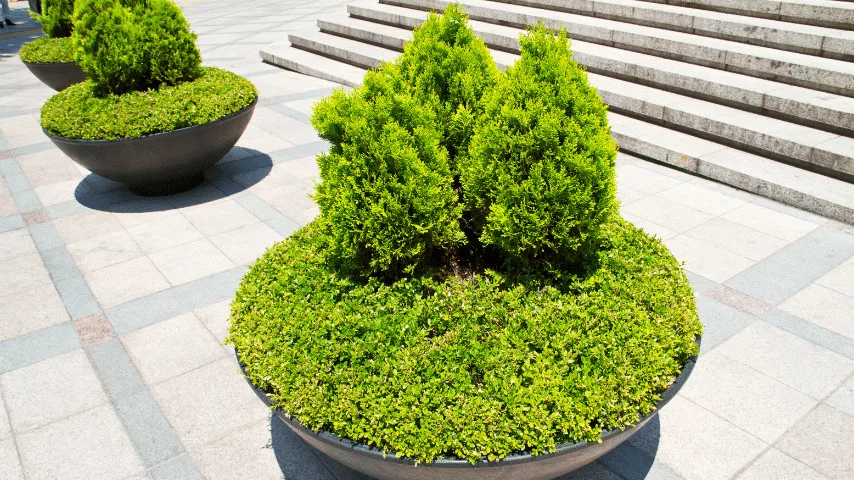
Arborvitae lush green plant grows 6 or 7 times larger than its root size. Therefore, if you are looking for some shade and privacy, this is the plant for you.
Choose the planter wisely as this plant can get quite huge. Moreover, you will need some handy cutters to keep the growth in check.
Its binomial nomenclature and fundamental plant care requirements are as follows:
- Scientific Name: Thuja
- Family: Cupressaceae
- Temperature: 59⁰ F to 77⁰ degrees Fahrenheit (15 – 25 degrees Celsius)
- Fertilizer: slow-release fertilizer with over 50% nitrogen
- pH: 6.5 to 8
- Soil: moderately alkaline
- Lighting: 6 hours and more o
- Growth rate: extremely fast growth rate
- Humidity: 80-95% humidity is recommended
7. Canna Lily
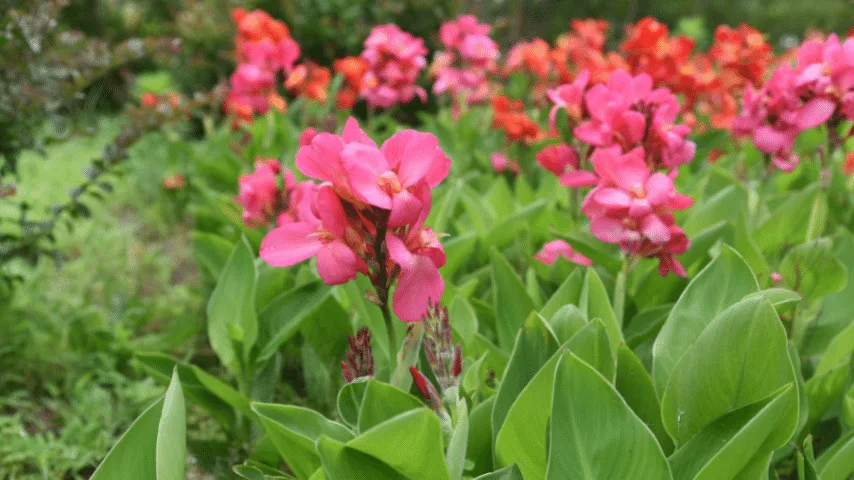
Canna Lily is one gorgeous plant with striking colors against lush-green foliage. Despite its delicate appeal, this is a hardy plant that flourishes in a variety of environments.
It is a low-maintenance flowering plant that blooms in the spring.
Its binomial nomenclature and fundamental plant care requirements are as follows:
- Scientific Name: canna
- Family: Cannaceae
- Temperature: 50⁰ F – 90⁰ degrees Fahrenheit (10 – 35 degrees Celsius)
- Fertilizer: does not need fertilizer
- pH: 6.0 to 6.5
- Soil: moist, well-draining soil
- Lighting: at least 4 hours or so
- Growth rate: moderate growth rate
- Humidity: 60-80% humidity is recommended
8. Princess Flower

This beautiful flowering plant is stunning to look at. The purple flowers against the green backdrop make it the center of attention on any balcony.
While this is a large plant, it can be cultivated in a balcony pot.
Its binomial nomenclature and fundamental plant care requirements are as follows:
- Scientific Name: Tibouchina Urvilleana
- Family: Melastomes
- Temperature: 65⁰ F to 75⁰ degrees Fahrenheit (18.33 to 23.888 degrees Celsius)
- Fertilizer: manure and acidic fertilizer
- pH: 6 to 7
- Soil: well-drained rich soil
- Lighting: 5 hours or so of direct sunlight
- Growth rate: extremely fast growth rate
- Humidity: 50-80% humidity is recommended
9. Hops
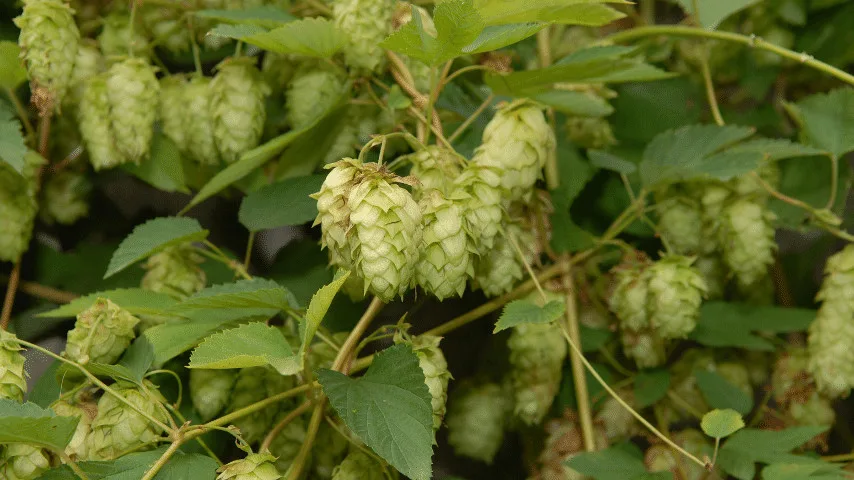
The lime green leaves of a hops plant are worth the effort you must put into choosing the right container.
As the roots of this plant can grow more than the average plant, you must make some adjustments for it.
Its binomial nomenclature and fundamental plant care requirements are as follows:
- Scientific Name: Humulus lupulus
- Family: Hemp
- Temperature: 68⁰ F to 72⁰ degrees Fahrenheit (20 to 22.22 degrees Celsius)
- Fertilizer: phosphorus and nitrogen-rich
- pH: 6 to 6.5
- Soil: well-drained, sandy, and loamy soil
- Lighting: 12 hours or so of direct sunlight
- Growth rate: extremely fast growth rate
- Humidity: 60-90% humidity is recommended
10. Rose of Sharon
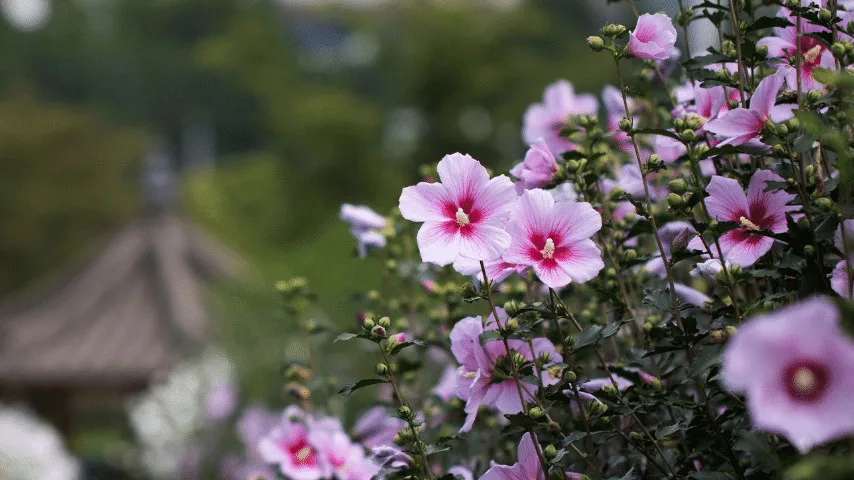
Rose of Sharon hibiscus plant grows well in balconies that require some shielding from the sun.
You must prune this plant carefully because it can grow up to 12 feet tall. Aside from that, this is a plant that requires little attention.
Its binomial nomenclature and fundamental plant care requirements are as follows:
- Scientific Name: hibiscus syriacus
- Family: mallows
- Temperature: -20⁰ F to 42.8⁰ degrees Fahrenheit (-28.88 to 6 degrees Celsius)
- Fertilizer: balanced fertilizer
- pH: 5.5 to 7.5
- Soil: moderately acidic and well-draining soil
- Lighting: 6 hours or so of direct sunlight
- Growth rate: extremely fast growth rate
- Humidity: 40-60% humidity is recommended
11. Viburnum
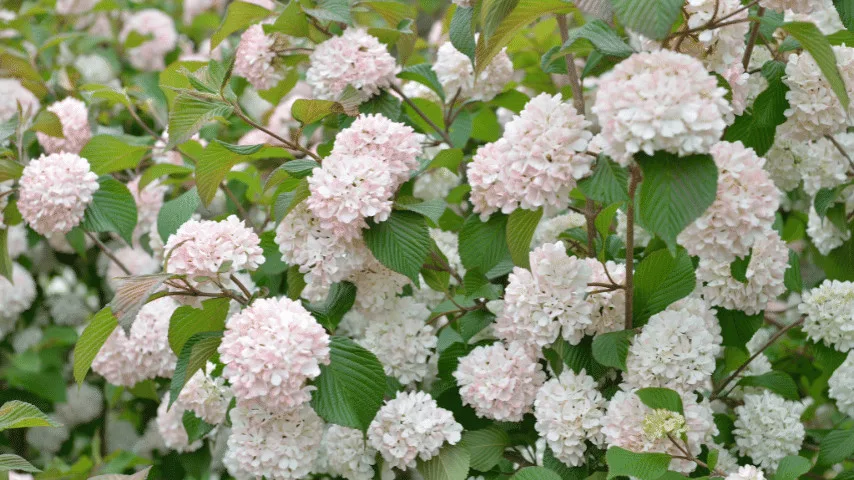
This shrub can grow in potted conditions. Since the root ball is wide, you must choose a pot that can accommodate free growth.
The beautiful white flowers enjoy the sun but will grow in shaded areas as well.
Its binomial nomenclature and fundamental plant care requirements are as follows:
- Scientific Name: viburnum
- Family: Moschatel
- Temperature: 20⁰ F to 50⁰ degrees Fahrenheit (-6.66 to 10 degrees Celsius)
- Fertilizer: organic fertilizer
- pH: 5.5 to 6.5
- Soil: well-drained, moist, and mildly acidic
- Lighting: 8 hours or so of direct sunlight
- Growth rate: moderate growth rate
- Humidity: 71-90% humidity is recommended
12. Dracaena
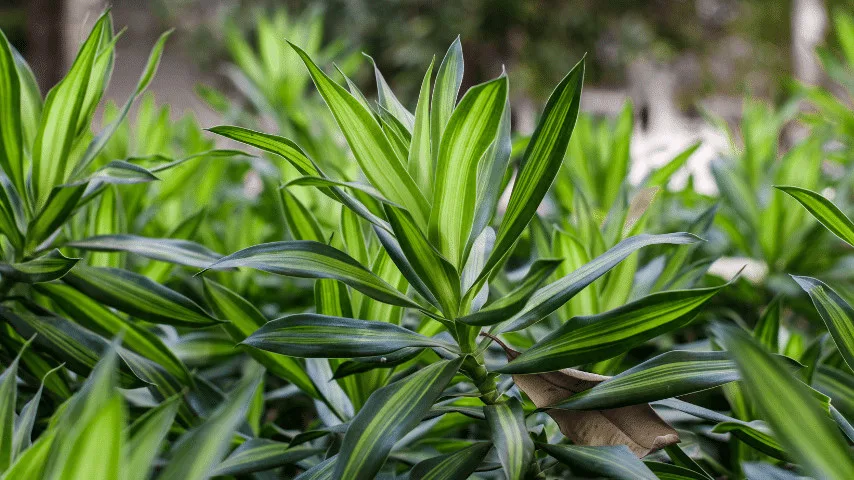
Dracaena indoor plant can thrive in shaded balconies and doesn’t require ample sunlight.
Since these can be growly fairly large, you might want to invest in some larger pots that can tolerate the growth.
Its binomial nomenclature and fundamental plant care requirements are as follows:
- Scientific Name: dracaena
- Family: Asparagaceae
- Temperature: 65⁰ F to 75⁰ degrees Fahrenheit (18.33 to 23.888 degrees Celsius)
- Fertilizer: water-soluble house plant fertilizer
- pH: 6 to 6.5
- Soil: well-drained, rich chunky soil
- Lighting: indirect shaded sunlight
- Growth rate: moderate growth rate
- Humidity: 60-80% humidity is recommended
13. Skip Laurel
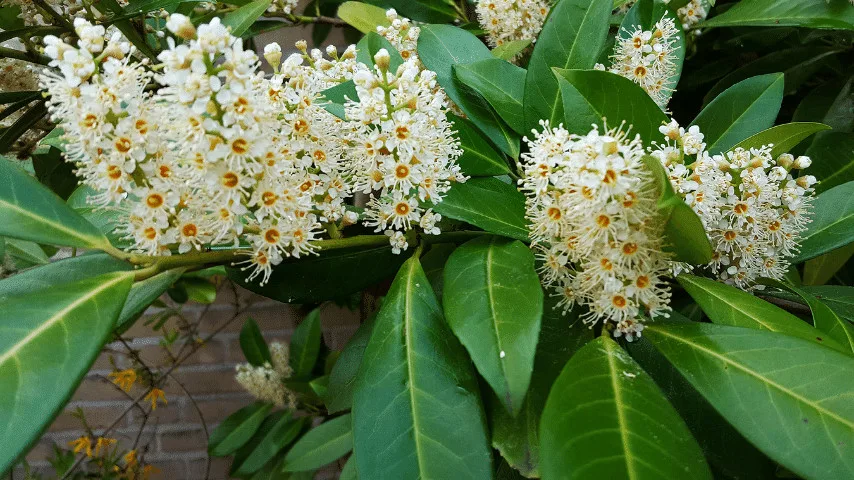
The leaves on this shrub are breathtaking. The orange-yellow toned leaves form the contrast with the green is striking.
This is a shrub that will grow tall and even produce some gorgeous flowers along the way.
Its binomial nomenclature and fundamental plant care requirements are as follows:
- Scientific Name: Prunus Laurocerasus
- Family: Rosacaea
- Temperature: 14⁰ F to 90⁰ degrees Fahrenheit (-10 to 32.22 degrees Celsius)
- Fertilizer: regular fertilizer during spring
- pH: 6 to 6.5
- Soil: clay, alkaline, or sandy soils must be well-draining
- Lighting: 6 hours of sunlight with some shade
- Growth rate: slow growth rate
- Humidity: 30-60% humidity is recommended
14. Amarnath
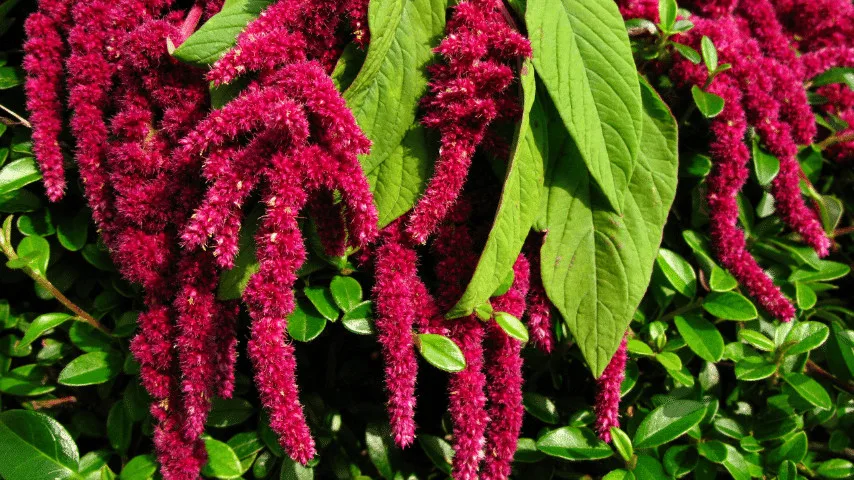
Amarnath is a weed with many benefits. This can be steeped for tea, turned into flour, or used as an ornament.
The striking purple and the maroon color are one of the many reasons you should have it on your balcony.
Its binomial nomenclature and fundamental plant care requirements are as follows:
- Scientific Name: Amaranthus
- Family: Amaranthaceae
- Temperature: 70⁰ F to 85⁰ degrees Fahrenheit (21.11 to 29.44 degrees Celsius)
- Fertilizer: balanced organic fertilizer
- pH: 6.5 to 7
- Soil: well-drained, moist soil
- Lighting: 6 hours of direct sunlight
- Growth rate: fast to the moderate growth rate
- Humidity: 60-80% humidity is recommended
15. Fuchsia
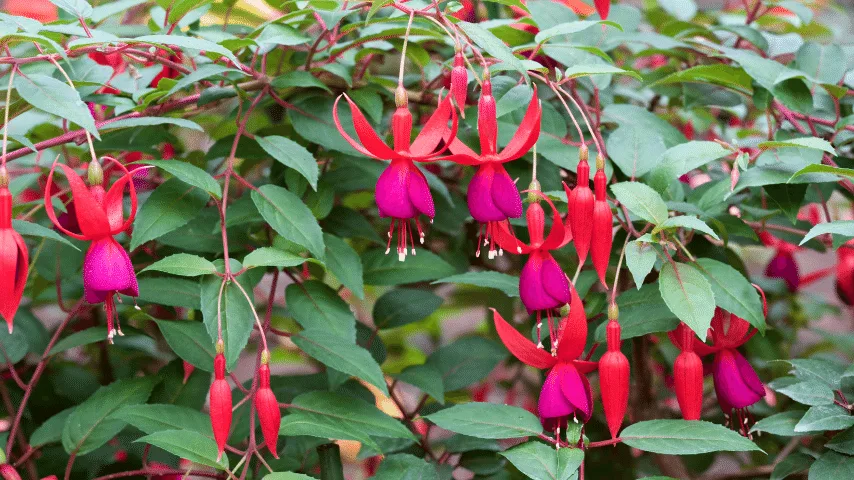
Fuchsia flowering plant enjoys the shade. If you have limited sunlight on your balcony, then this plant is the right fit for you.
The flowers on this plant transition from a mild pink to a vibrant purple.
Its binomial nomenclature and fundamental plant care requirements are as follows:
- Scientific Name: fuchsia
- Family: Onagraceae
- Temperature: 60⁰ F to 70⁰ degrees Fahrenheit (15.55 to 21.11 degrees Celsius)
- Fertilizer: balanced/hardy fertilizer
- pH: 6 to 7
- Soil: moist and well-draining
- Lighting: 4 hours or more
- Growth rate: relatively slow growth rate
- Humidity: 40-60% humidity is recommended
16. Horsetail
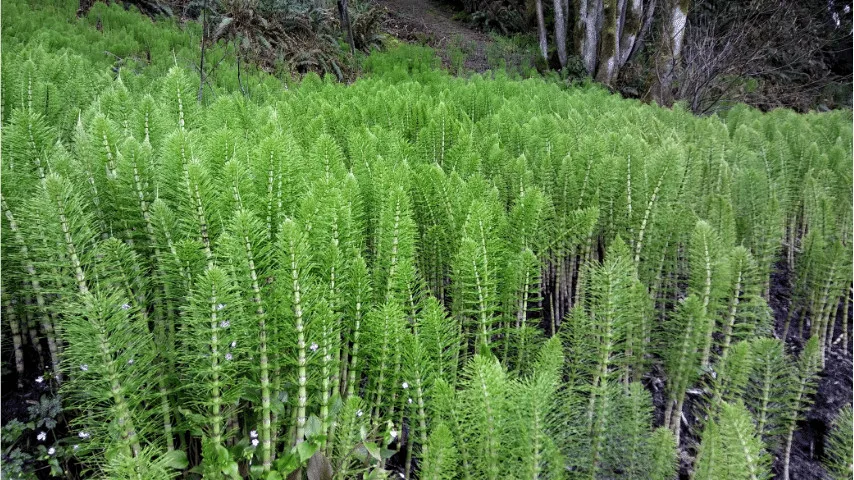
This is an evergreen plant that does not flower. The minimal appeal of this basic plant is enough to make it a favorite among balcony-approved plants.
Its binomial nomenclature and fundamental plant care requirements are as follows:
- Scientific Name: Equisetum
- Family: Horsetail family
- Temperature: -40⁰ F to -30⁰ degrees Fahrenheit (-40 to -34.44 degrees Celsius)
- Fertilizer: water-soluble house plant fertilizer
- pH: 7 to 8
- Soil: moist and well-drained
- Lighting: 5 hours or more of shaded light
- Growth rate: moderate growth rate
- Humidity: 50-75% humidity is recommended
17. Hydrangea
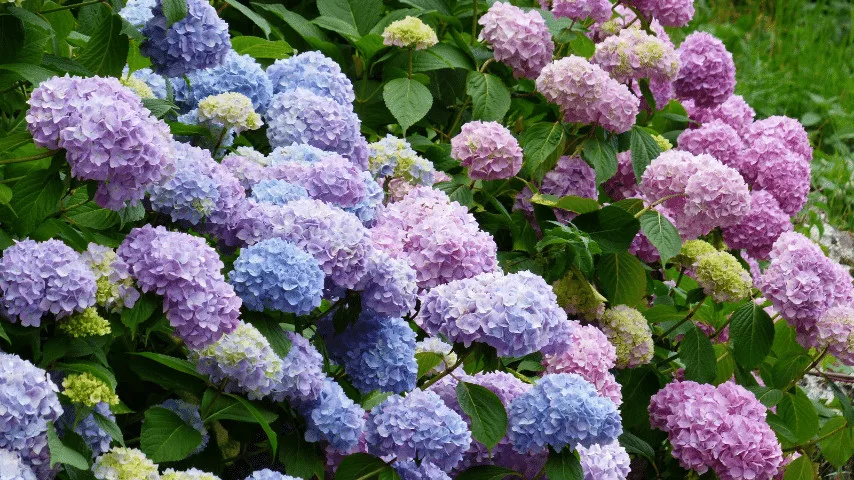
Hydrangeas are flowering plants that can brighten up any dull space. If your balcony is relatively spacious, this is the plant you should go for.
Its binomial nomenclature and fundamental plant care requirements are as follows:
- Scientific Name: Hydrangea
- Family: Hydrangeaceae
- Temperature: 50⁰ F to 60⁰ degrees Fahrenheit (10 to 15.55 degrees Celsius)
- Fertilizer: all-purpose and well-balanced
- pH: 5 to 6.5
- Soil: loam soil, friable
- Lighting: partial sunlight
- Growth rate: moderate growth rate
- Humidity: 40-60% humidity is recommended
18. Elderberry
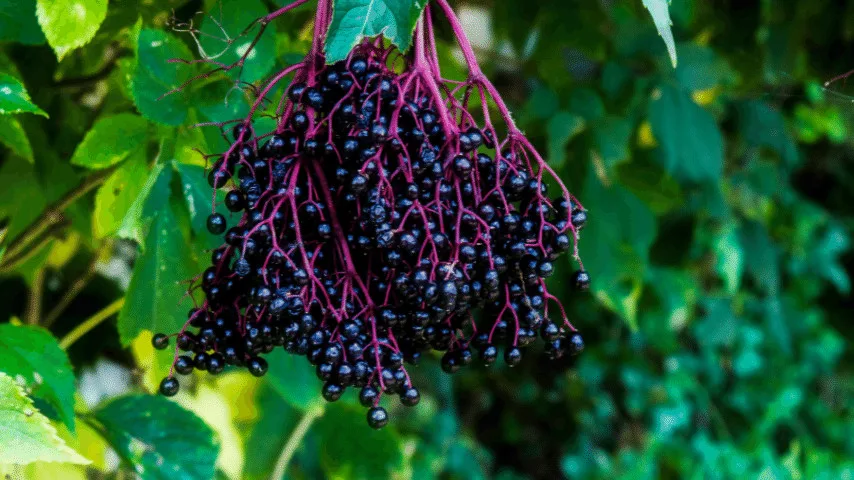
If you are someone who enjoys a roof-top garden, then you can grow some elderberries.
While this isn’t a plant that usually grows in pots, with some extra care, you can enjoy its fragrant flowers and delicious fruits.
Its binomial nomenclature and fundamental plant care requirements are as follows:
- Scientific Name: Sambucus
- Family: Adoxaceae
- Temperature: -35⁰ F to 40⁰ degrees Fahrenheit (-37.22 to 4.44 degrees Celsius)
- Fertilizer: Ammonium nitrate-based fertilizer
- pH: 5.5 to 6.5
- Soil: fertile, well-drained soil
- Lighting: full, direct sunlight
- Growth rate: slow growth rate
- Humidity: 40-60% humidity is recommended
19. Switchgrass

Switchgrass is an ornamental plant that produces flowers during the spring months.
This is a plant that can grow to larger heights and create a boundary around the balcony’s fence if you want.
Its binomial nomenclature and fundamental plant care requirements are as follows:
- Scientific Name: Panicum virgatum
- Family: Poaceae
- Temperature: 77⁰ F to 95⁰ degrees Fahrenheit (25 to 35 degrees Celsius)
- Fertilizer: nitrogen-rich fertilizer
- pH: 6.0 to 9.0
- Soil: clay, loamy or sandy
- Lighting: 6 hours or partial or shaded sunlight
- Growth rate: moderate growth rate
- Humidity: 50-75% humidity is recommended
20. Elephant Ear
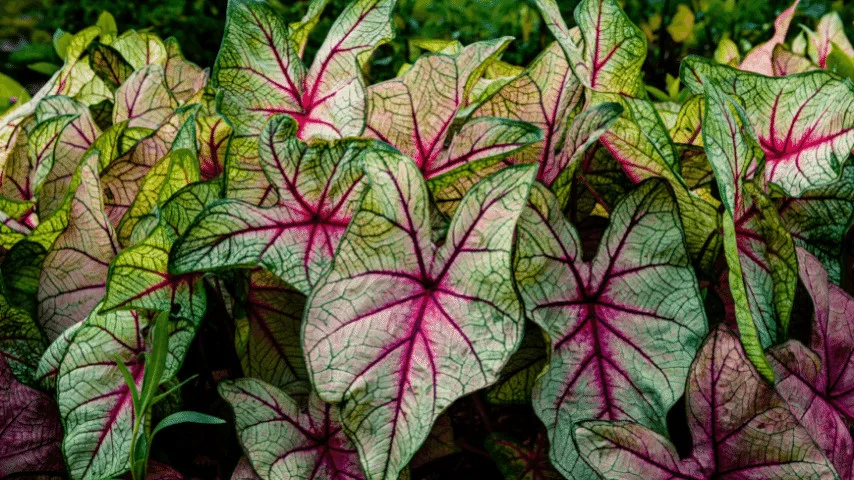
The lush green foliage is stunning, to say the least. Despite the size it can achieve, this is a household favorite.
Given that you use the right pots for it, an Elephant ear can be ornamental and add to the privacy all the same.
Its binomial nomenclature and fundamental plant care requirements are as follows:
- Scientific Name: Hydrangea
- Family: Hydrangeaceae
- Temperature: 50⁰ F to 60⁰ degrees Fahrenheit (10 to 15.55 degrees Celsius)
- Fertilizer: all-purpose and well-balanced
- pH: 5 to 6.5
- Soil: loam soil, friable
- Lighting: partial sunlight
- Growth rate: moderate growth rate
- Humidity: 40-60% humidity is recommended
21. Holly

This is a relatively low-maintenance plant that just needs a lot of water when grown in a pot.
Hollies are generally associated with the Christmas season because of the gorgeous scarlet against deep green foliage.
Its binomial nomenclature and fundamental plant care requirements are as follows:
- Scientific Name: IIex
- Family: Aquifoliaceae
- Temperature: 20⁰ F to 25⁰ degrees Fahrenheit (-6.66 to -3.88 degrees Celsius)
- Fertilizer: well-rotten livestock manure
- pH: 5.0 to 6.0
- Soil: well-draining moist soil
- Lighting: 4 hours of partial sunlight
- Growth rate: slow growth rate
- Humidity: 20-30% humidity is recommended
22. Fountain Grass

This is an ‘outdoorsy’ plant. This bush-like grass is a flowering plant that grows well under a lot of sunlight but adapts to shade rather quickly.
Its binomial nomenclature and fundamental plant care requirements are as follows:
- Scientific Name: Pennisetum setaceum
- Family: Poaceae
- Temperature: 75⁰ F to 85⁰ degrees Fahrenheit (23.88 to 29.44 degrees Celsius)
- Fertilizer: slow-release moderate nitrogen fertilizer
- pH: 5.5 to 7.0
- Soil: loamy fertile soil
- Lighting: 6 hours of direct sunlight
- Growth rate: fast growth rate
- Humidity: 60-90% humidity is recommended
23. Clematis
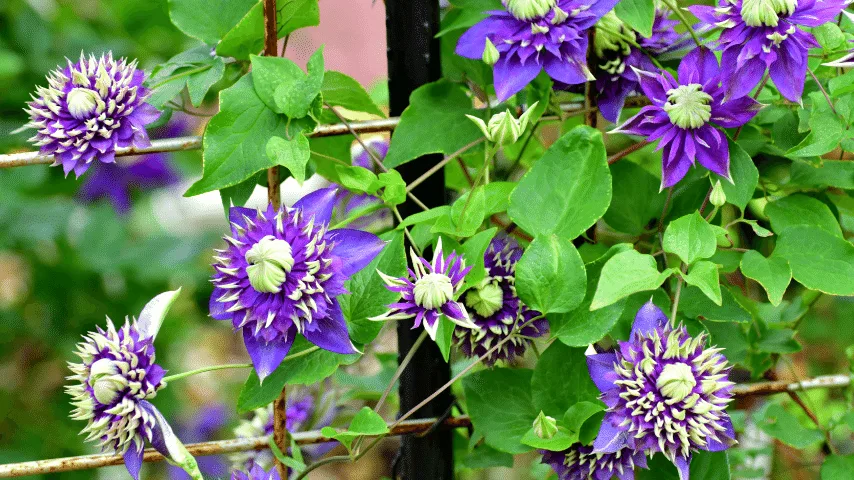
Clematis plant produces the prettiest flowers. The mauve, blue and vibrant purples add so much personality to the balcony.
This plant works well in pots, and a rectangular pot that gives the plant enough room to expand is the right fit for this plant.
Its binomial nomenclature and fundamental plant care requirements are as follows:
- Scientific Name: Clematis
- Family: Ranunculaceae
- Temperature: 45⁰ F to 60⁰ degrees Fahrenheit (7.22to 15.55 degrees Celsius)
- Fertilizer: low-nitrogen fertilizer
- pH: 6.5 to 7
- Soil: moist, fertile, well-draining
- Lighting: 6 hours of full sun
- Growth rate: fast growth rate
- Humidity: 30-60% humidity is recommended
24. Junipers

Growing them is quite fun if you are a fan of junipers. However, the potted variety is highly recommended for balconies.
Option for a larger pot that gives this plant to thrive and expand.
Its binomial nomenclature and fundamental plant care requirements are as follows:
- Scientific Name: Juniperus
- Family: Juniperaceae
- Temperature: 10⁰ F to 15⁰ degrees Fahrenheit (-12 to 29 degrees Celsius)
- Fertilizer: well-balanced fertilizer
- pH: 5.5 to 7
- Soil: well-drained loamy and sandy soil
- Lighting: 4 hours or more of sunlight
- Growth rate: moderate growth rate
- Humidity: 40-60% humidity is recommended
25. Areca Palm
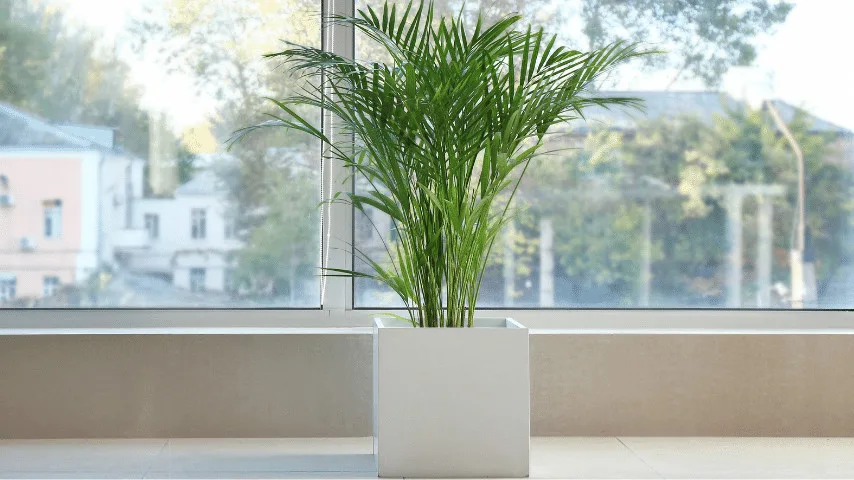
Areca Palm is exotic, lush-green foliage that you can grow in a pot. This variety of palms does not require extreme care and can adapt to growing in pots on a balcony.
Its binomial nomenclature and fundamental plant care requirements are as follows:
- Scientific Name: Dypsis lutescens
- Family: Palms
- Temperature: 65⁰ F to 75⁰ degrees Fahrenheit (18 to 24 degrees Celsius)
- Fertilizer: moderate nitrogen-based fertilizer
- pH: 6.1 to 6.5
- Soil: peat moss, porous soil
- Lighting: 6 hours or more of direct sunlight
- Growth rate: slow growth rate
- Humidity: 40-60% humidity is recommended
26. Yucca
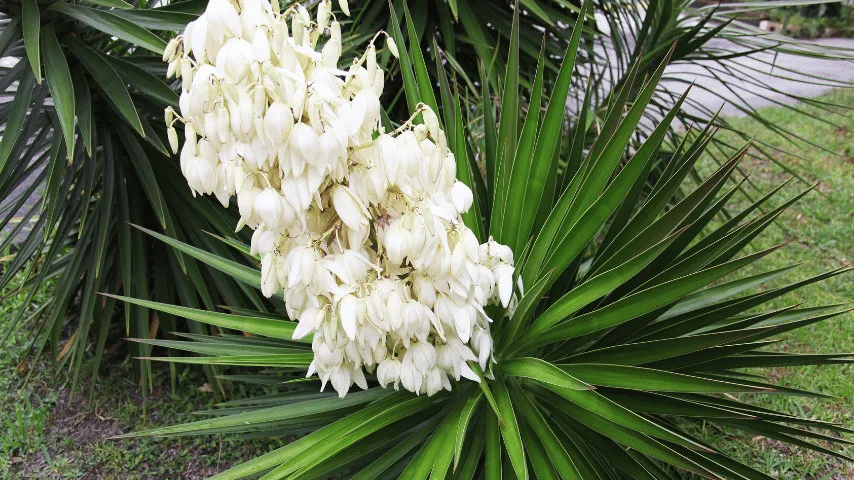
Yucca is a privacy plant that graces many balconies. All it needs is a few hours of the morning sun and an indoor spot during the winters.
Make sure the pot is big enough to hold the plant upright and give the roots room to grow.
Its binomial nomenclature and fundamental plant care requirements are as follows:
- Scientific Name: Yucca filamentosa
- Family: Asparagaceae
- Temperature: 65⁰ F to 95⁰ degrees Fahrenheit (18.33 to 35 degrees Celsius)
- Fertilizer: well-balance, low-nitrogen fertilizer
- pH: 5.5 to 6
- Soil: acidic, rich, and fertile
- Lighting: 4 hours or more of partial sunlight
- Growth rate: Slow to a moderate growth rate
- Humidity: 10-60% humidity is recommended
27. Bird of Paradise

Beautiful! One word that perfectly describes Bird of Paradise’s leafy green plant. It can grow quite a bit but does not need more care than an average plant.
White pots do wonders against the contrast of the deep green foliage.
Its binomial nomenclature and fundamental plant care requirements are as follows:
- Scientific Name: Strelitzia
- Family: birds-of-paradise plants
- Temperature: 65⁰ F to 80⁰ degrees Fahrenheit (18.33 to 26.66degrees Celsius)
- Fertilizer: well-balanced fertilizer with phosphorus, potassium, and nitrogen
- pH: 5.5 to 7.5
- Soil: slightly acidic potting mix
- Lighting: 6 hours or more of direct sunlight
- Growth rate: moderate growth rate
- Humidity: 50-70% humidity is recommended
28. Norfolk Island Pine
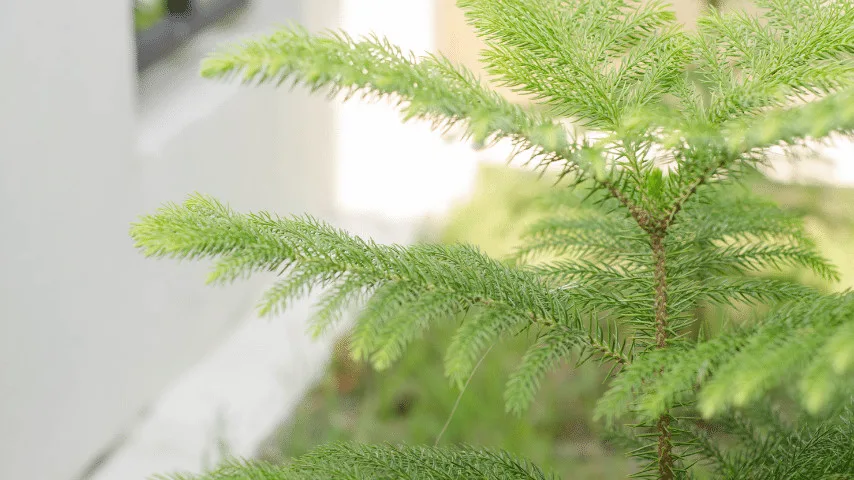
This is your indoor Christmas tree. The green pine doesn’t need much in terms of care.
The right fertilizer, adequate sunlight, and proper watering are enough to grow some beautiful potted pine on your balcony.
Its binomial nomenclature and fundamental plant care requirements are as follows:
- Scientific Name: Araucaria heterophylla
- Family: Araucariaceae
- Temperature: 55⁰ F to 70⁰ degrees Fahrenheit (12.77 to 21.11 degrees Celsius)
- Fertilizer: slightly acidic liquid fertilizer
- pH: 4.5 to 5.5
- Soil: sandy, porous soil
- Lighting: 6 hours of direct sunlight
- Growth rate: slow growth rate
- Humidity: 15-50% humidity is recommended
29. Boxwood
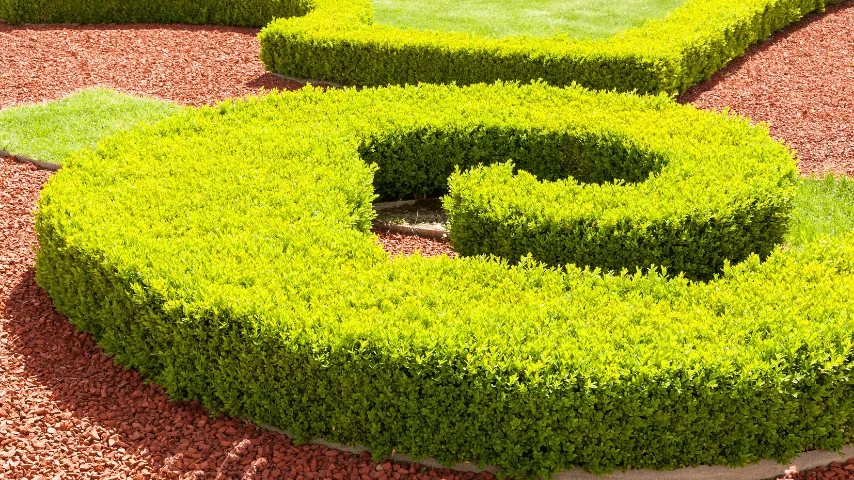
Boxwood is, in essence, a hedge plant. But with some snipping here and the right pot there, you can enjoy the privacy of a boxwood hedge right on your balcony.
Its binomial nomenclature and fundamental plant care requirements are as follows:
- Scientific Name: Buxus
- Family: Buxacaceae
- Temperature: 60⁰ F to 80⁰ degrees Fahrenheit (15.55 to 26.66 degrees Celsius)
- Fertilizer: slow-release, balanced and granular
- pH: 6.5 to 7
- Soil: Slightly acidic, well-draining soil
- Lighting: 6 hours of shaded sunlight
- Growth rate: slow growth rate
- Humidity: 60-80% humidity is recommended
30. Sweet Bay Laurel
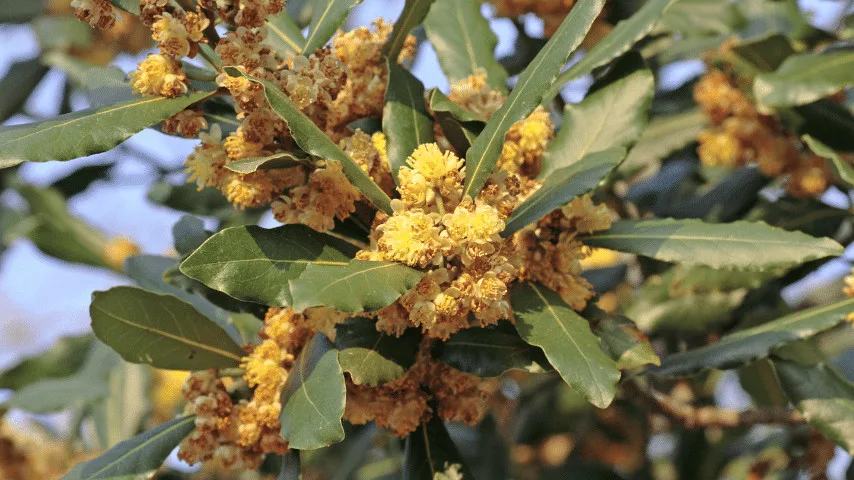
This is an edible plant used for its aroma in several dishes. The gorgeous green leaves can be potted to grow into a compact yet tall plant for the balcony.
Its binomial nomenclature and fundamental plant care requirements are as follows:
- Scientific Name: Laurus nobilis
- Family: Lauraceae
- Temperature: 45⁰ F to 64⁰ degrees Fahrenheit (7.22to 17.777degrees Celsius)
- Fertilizer: well-balanced liquid fertilizer
- pH: 4.5 to 8.3
- Soil: well-drained sandy or rocky soil
- Lighting: 8 hours or more of sunlight
- Growth rate: Slow to the moderate growth rate
- Humidity: 60-90% humidity is recommended
Read about Ruscus aculeatus care next.

Daniel has been a plant enthusiast for over 20 years. He owns hundreds of houseplants and prepares for the chili growing seasons yearly with great anticipation. His favorite plants are plant species in the Araceae family, such as Monstera, Philodendron, and Anthurium. He also loves gardening and is growing hot peppers, tomatoes, and many more vegetables.

![30 Best Plants for Balcony – Top List [2024]](https://plantophiles.com/wp-content/uploads/2022/05/30-Best-Plants-for-Balcony-1-720x405.jpg.webp)
